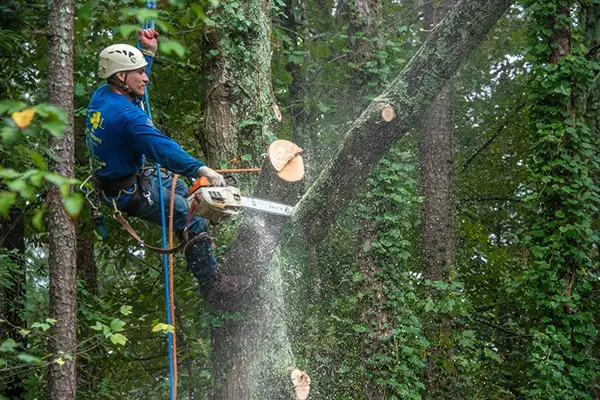When it comes to storm preparedness, you might not think of your trees as a concern. However, neglected trees can become serious hazards during severe weather.
By understanding the importance of regular tree trimming, you can significantly reduce the risk of storm damage.
This practice not only enhances the tree’s health but also helps safeguard your property. So, what are the best strategies for keeping your trees storm-ready? Let’s explore.
Understanding the Risks of Neglected Trees
Neglecting tree maintenance can lead to serious safety hazards and costly damage.
Potential Safety Hazards
Overlooking tree care can create risks for your property and those nearby.
- Falling Branches: Weak or diseased limbs are more likely to break during storms.
- Property Damage: Unstable trees can fall onto homes, vehicles, or fences.
- Obstructed Visibility: Overgrown branches may block driveways, sidewalks, or street signs, posing risks for drivers and pedestrians.
Health and Environmental Concerns
Neglected trees can negatively impact your landscape and the surrounding environment.
- Pest Infestations: Diseased or decaying trees attract harmful insects that may spread to healthy plants.
- Spreading Diseases: Unchecked infections can compromise nearby vegetation.
- Weakened Growth: Lack of care may stunt the tree’s development and impact its longevity.
Financial Impact
Ignoring tree issues can lead to significant expenses down the line.
- Costly Repairs: Fallen trees or branches can result in high repair costs for property damage.
- Insurance Issues: Neglected tree hazards may limit your insurance coverage for storm-related claims.
- Decreased Property Value: Poorly maintained trees can reduce your home’s curb appeal.
By understanding these risks, you can prioritize tree maintenance, protecting both your property and the surrounding environment.
Benefits of Regular Tree Trimming
Routine trimming offers a range of benefits for both your trees and property.
Improved Tree Health
Regular trimming promotes stronger, healthier trees.
- Removes Dead or Diseased Branches: Prevents decay from spreading.
- Enhances Sunlight and Airflow: Encourages healthy growth.
- Promotes New Growth: Leads to denser foliage and improved fruit or flower production.
Enhanced Safety and Protection
Proper trimming reduces the risk of property damage and accidents.
- Prevents Falling Branches: Reduces the chance of limbs breaking during storms.
- Minimizes Overgrowth Risks: Keeps branches away from power lines and structures.
- Improves Visibility: Clears sightlines for drivers and pedestrians.
Aesthetic and Property Value
Well-maintained trees boost curb appeal and increase property value.
- Encourages a Neat Appearance: Shapes trees for a balanced, attractive look.
- Enhances Landscaping Design: Helps trees complement your outdoor space.
- Increases Longevity: Regular care ensures trees stay healthy for years to come.
By investing in regular tree trimming, you’re promoting a safer, healthier, and more visually appealing landscape.
Best Practices for Storm-Resilient Tree Maintenance
Proactive care can help your trees withstand severe weather conditions.
Routine Inspection and Pruning
Regular maintenance keeps your trees strong and stable.
- Inspect for Damage or Disease: Check for cracks, decay, or weak branches.
- Prune Dead or Weak Limbs: Reduces wind resistance and minimizes breakage risks.
- Balance the Canopy: A well-shaped tree can endure strong winds more effectively.
Root System and Soil Care
Healthy roots provide stability during storms.
- Avoid Compacted Soil: Loose, well-aerated soil supports deeper root growth.
- Watch for Exposed Roots: Address shallow roots to prevent instability.
- Water and Mulch Properly: Strengthens root development and improves soil conditions.
Tree Selection and Expert Advice
Choosing the right trees and guidance ensures lasting resilience.
- Plant Storm-Resilient Species: Select trees known for durability in your region.
- Position Trees Strategically: Keep them away from structures and power lines.
- Consult a Certified Arborist: Expert advice helps tailor care to your landscape’s needs.
By following these steps, you’ll improve your trees’ ability to withstand storms and maintain a safer, healthier outdoor space.
Regular tree trimming and proactive maintenance are essential for reducing storm damage risks and improving your landscape’s safety and appearance.
Proper care strengthens trees, helping them grow healthier and more resilient.
This investment safeguards your property while enhancing its natural beauty.

